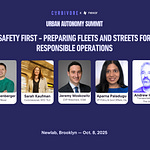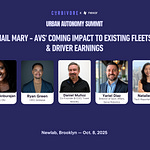Listen to this episode on Apple Podcasts, YouTube, Spotify, and Substack. We now have transcripts available too (Click on the “transcripts” button in the top right corner of this post to access them).
In today’s episode, I’m speaking with Hansu Kim, longtime San Francisco political consultant with 20+ years of experience in transportation policy and legislation, and Chairman of Flywheel Technologies, one of Uber’s taxi fleet partners, and taxi booking platform. We get into how the Flywheel–Uber partnership actually works, what the customer experience looks like, and how the taxi industry is responding to this model.
Hansu breaks down how Flywheel balances traditional taxi demand with Uber-induced trips, and how their approach boosts utilization while reducing congestion and emissions. We also talk about the benefits this model brings to drivers and TNCs, plus why taxi drivers still have a few meaningful advantages over regular rideshare drivers.
We then shift into the AV world, from how Uber uses similar fleet-partnership frameworks to onboard autonomous vehicle companies, to how robotaxis in San Francisco are affecting demand. Hansu shares where taxis could fill important gaps for AV operators, his take on Waymo’s challenges, how driver income might change as AVs scale, and how Flywheel is preparing for that future, including their work with Nexar on next-gen AI cameras.
Chapters
(00:00) Introduction to Hansu Kim
(01:25) Current state of the Flywheel-Uber partnership and the taxi industry
(03:20) Mechanics of the partnership, and the customer experience
(05:00) Is the Flywheel-Uber partnership model being embraced by the taxi industry?
(08:32) Flywheel’s demand distribution — Traditional taxi demand vs Uber induced demand
(09:21) How Flywheel maximizes vehicle utilization, and reduces congestion/pollution
(10:13) Benefits of the Flywheel-Uber partnership model to drivers and TNCs
(13:00) Flywheel’s business structure
(19:58) Advantages of taxi drivers over regular rideshare drivers
(23:30) How Uber uses the same fleet partnership model for autonomous vehicle companies
(25:10) How AV companies benefit from TNC/taxi partnerships
(26:15) Waymo’s challenges in SF, and how Flywheel could help (Disabled customers etc)
(29:39) How have robotaxis in SF impacted taxi/rideshare demand?
(32:20) How would taxi driver income change with the advent of AVs
(34:18) Would AVs eventually compete with Taxis?
(36:07) How Flywheel is preparing for the AV future
(40:15) How Flywheel is partnering with Nexar for their new generation AI cameras
(42:34) Hansu’s overall assessment of Waymo
(45:12) Conclusion and final notes
Notes/Links:
Hansu’s previous appearance on The Rideshare Guy podcast: Order An Uber Get A Taxi?! Uber X Taxis | RSG 207 (link).
RSG contributor Jay Cradeur tried out taxi driving with Flywheel: What’s It Like To Be A Taxi Driver vs an Uber Driver? (link).
-Harry
Thanks for being a subscriber to The Driverless Digest! If you enjoyed this episode, feel free to share it with someone who might like it too. And if this email was forwarded to you, why not subscribe and stick around :)









